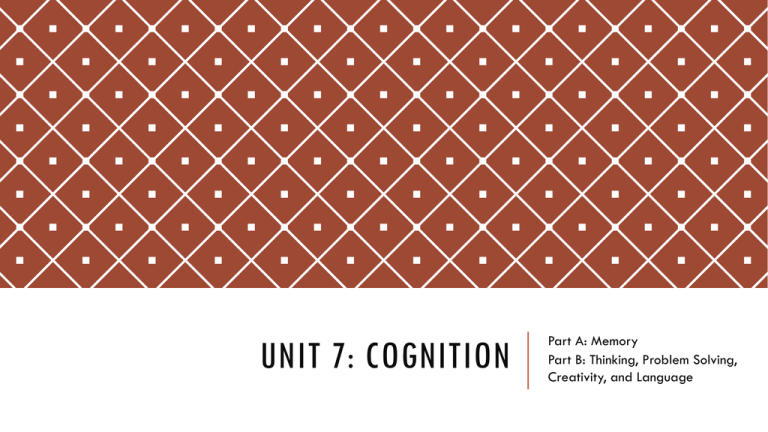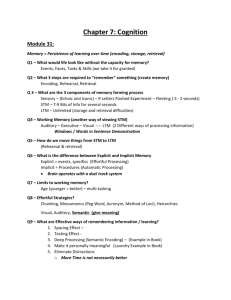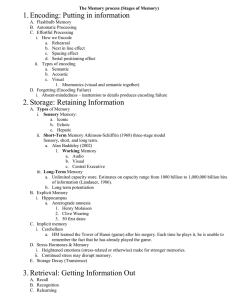Unit 7: Cognition
advertisement

UNIT 7: COGNITION Part A: Memory Part B: Thinking, Problem Solving, Creativity, and Language UNIT 7A: MEMORY https://m.youtube.com/watch?v=kXJUt6XUtQ0 SO…WHAT EXACTLY IS “MEMORY”? Memory is information from personal experiences that has lasted over a relatively extended period of time that has been stored and can be retrieved. THE PROCESS OF … INFORMATION PROCESSING: The process by which information goes through within the brain: 1. Encoding (getting information into the brain in a way that makes sense) 2. Storage (retaining information) 3. Retrieval (getting the information when needed) PAIR-PARTNER DISCUSSION: How have you used the three parts of your memory system (encoding, storage, and retrieval) in learning something new today? WE FORM MEMORIES IN 3 STAGES… 1. Sensory memory (photographic memory…fleeting) Cue the memory game: 2. Short-term memory/Working memory (lasts for as long as information is rehearsed regularly) 3. Long-term memory (stored indefinitely) ENCODING: GETTING INFORMATION IN… 1. Automatic Processing – done without being consciously aware of the process *Parallel processing – multi-tasking in taking in information in SPACE, TIME, FREQUENCY, and WELL-LEARNED INFORMATION Example: While conversing with your friend as you are walking through the doors of a mall during the holidays you simultaneously subconsciously take note of the colorful decorations, the holiday train express beeping as it circles the food court, two kids crying, the number of times that the Santa says “Ho, Ho, Ho!”, and the level of patience that the line of 8 kids waiting to sit on Santa’s lap. 2. Effortful Processing - consciously aware of producing durable and accessible memories *Rehearsal – conscious repetition Example: Purposefully memorizing the periodic table for your Physics class by next Tuesday’s unit test. * Spacing effect: learning information in parts over an extended period of time is more effective than “cramming” * Serial position effect: the tendency to remember the first and last items in a list of things better than the items in the middle of the list. WHAT WE ENCODE… A) visual encoding – processing seen images to make sense within the brain Imagery – mental pictures Mnemonic – memory helps such as acronyms, songs, associations Chunking – grouping numbers, words, etc in order to retain information longer B) acoustic encoding – processing sounds to assess meaning C) semantic encoding – processing meaning words; including the tone of voice and choice of words STORAGE: RETAINING INFORMATION Sensory Memory: Iconic memory – fleeting photographic memory Example: Used when playing a memory card game Echoic memory – fleeting auditory memory Example: Used when repeating what the actor just said during a movie to someone who did not quite catch it. Working/Short-term Memory: As long as you are using the information or rehearsing the information, the information is readily available Long-Term Memory: Information that is stored indefinitely, short of the development of cognitive disorders/ CRASH COURSE VIDEO: HTTPS://M.YOUTUBE.COM/WATCH?V=BSYCDIX -C48 UNDERSTANDING THE BIOLOGY OF MEMORY How does the brain store our memories? 1. Synaptic changes occur as an individual has new experiences. 2. Long-term potentiation (LTP) is potential neural firing that creates the ability to learn and remember associations. a) Certain drugs can block LTP and interfere with learning. b) Findings in experiments with mice showed that deficiencies in LTP resulted in decreased ability in learning and abundance in LTP resulted in increased ability in learning. STORING IMPLICIT AND EXPLICIT MEMORIES Implicit vs. Explicit Memories Implicit – non-declarative memory OR procedural memory…knowing HOW to do something Example: Remembering that your mom tied on her apron before she starting preparing food without fail, although this fact was never a topic or subtopic of conversation. Example: Remembering the process of how to change oil in your car and doing so without consciously thinking about it. Explicit – declarative memories…being conscious of your knowledge and learning HIPPOCAMPUS & CEREBELLUM The hippocampus is a part of the limbic system, whose responsibility is to control emotion, memories, and arousal. * The hippocampus plays an important role in forming memories about past experiences. * The cerebellum helps with forming and storing implicit memories. * PAIR PARTNER DISCUSSION: Can you name an instance in which stress has helped you remember something, and another instance in which stress has interfered with remembering something? RETRIEVAL: GETTING INFORMATION OUT Ways to retrieve… 1. Recall 2. Recognizing 3. Relearning RETRIEVAL CUES… Priming: “wakening of associations”…giving a cue to bring about a “flood of stored information” Example: Giving the spelling bee participant who is practicing for the competition the meaning of the root word. Context Effects – putting stored information into perspective in order to retrieve the information Deja’ vu: the feeling that a person has experienced something before Mood congruent: being in the same mood as when the memory was formed helps to remember the details. SEVEN (7) WAYS MEMORIES SLIP AWAY… 1. Absent-mindedness: not paying attention to details leads to encoding failure 2. Transience: storage decay over time 3. Blocking: not being able to access stored information 4. Misattribution: being confused about the source of information (assuming someone said or did something when it didn’t happen) 5. Suggestibility: the by-products of misinformation (having someone suggest something, leads an individual to believe that something exist or happened) 6. Bias: emotions at the time of the event cause inaccuracy of events. 7. Persistence: unwanted, tragic, scary, or devastating memories RETRIEVAL FAILURE Proactive interference: when old learning blocks new learning. Example: You moved to a new residence last week. Someone asks you today for your address, but you flinch as you realize you can only remember your old address and not the new address. Retroactive interference: when new learning blocks old learning. • Example: You moved to your new residence 6 months ago. Someone asks you for your prior address, but you flinch as you realize you no longer can recall your old address, but only able to remember your new address. HOW TO IMPROVE MEMORY 1. Study repeatedly over an extended period of time. No Cramming! 2. Make the information relatable/meaningful. 3. Activate retrieval cues (emotions/situations). 4. Use mnemonic devices. 5. Minimize interference. 6. Sleep more. UNIT 7B: THINKING, PROBLEM SOLVING, CREATIVITY, AND LANGUAGE THINKING/COGNITION Refers to all mental activities including remembering, knowing, and communicating with others. Concepts: grouping ideas, objects, events, and people into a mental construct. Developing PROTOTYPES occurs when we are given a definition by which we form a mental image that serves as an example. PAIR PARTNER ACTIVITY: Creating a prototype: Create a detailed profile for an imaginary person for your classmates to guess the imaginary person’s profession. WAYS TO SOLVE PROBLEMS… 1. Strategies Algorithms: step-by-step procedures that ensure an accurate solution Heuristics: a shortcut to finding a solution; simpler strategy Insight: being able to suddenly see a solution 2. Creativity Five Components of Creativity (Sternberg; Sternberg & Lubart) 1. Expertise on a topic or skill 2. Imaginative thinking skills 3. Adventuresome personality 4. Intrinsic motivation 5. A creative environment OBSTACLES TO PROBLEM SOLVING: 1. Confirmation bias: tendency to seek information to verify our ideas rather than seriously considering information that might contradict them. 2. Fixation: the inability to see a problem from a fresh perspective. Mental set: predisposes what we perceive Functional fixedness: being able to only see the original or typical use of an object, event, etc. MAKING DECISIONS AND FORMING JUDGMENTS 1. Representativeness Heuristic: judging how well things measure up to what they are to represent or match prototypes; may influence decisions and judgments 2. Availability Heuristic: judging based upon how mentally available information is according to the recency, vividness, or distinctiveness; may influence decisions and judgments 3. Overconfidence: create by impulsivity to prove our intuition and disregard other facts that contradict it; may influence decisions and judgments 4. The Belief Perseverance Phenomenon: the tendency to cling to information that confirms our beliefs and reject information that contradicts it. 5. Intuition: inner feeling or thought created by conscious reasoning about information, person, or situation; may influence decisions and judgments 6. Framing: the way that information is presented; may influence decisions and judgments GROUP OF 4 DISCUSSION: Discuss the Pros and Cons of the 6 components on the previous slide of making decisions and forming judgments. LANGUAGE LANGUAGE STRUCTURE & DEVELOPMENT: Phonemes: the smallest distinctive sound unit Morphemes: the smallest unit that carries meaning Babbling stage: when babies are testing out their vocal chords; making random and repetitive sounds One-word stage: when babies learn singular words in their quest to communicate with those around them; just building vocabulary Examples: “Light,” “Mommy!” “Daddy” Two-word stage: when babies increase their communicative capability by using two words Example: “Go bye-bye” “Me hungry” Telegraphic speech: simplistic sentences formed by toddlers using mostly nouns and verbs with 2 or more words. Example: “Car go zoom-zoom!” “Go car” VIDEO ON LANGUAGE DEVELOPMENT https://www.youtube.com/watch ?v=a7WAfwKi88Q









